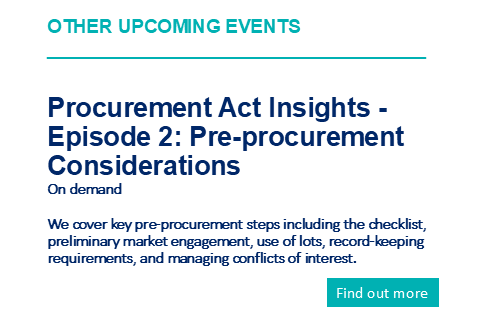- Details
‘How now, brown…field?’ – Legal considerations for councils in light of new brownfield funding
James Mallery-Nelson discusses the recent developments in planning relating to 'brownfield' land and how the government is helping councils make use of the sites.
The UK government has taken a significant step in addressing the need for the construction of new homes by providing £68 million of funding under the Brownfield Land Release Fund (the ‘Fund’) for 54 local authorities to enable the development of derelict and unused brownfield sites across the country.
The Fund is intended to enable councils to cover the expenses associated with the development of brownfield sites, such as undertaking decontamination, clearing buildings or detritus and improving utilities infrastructure.
The government has also announced the introduction of new ‘brownfield passports’ to enable the faster grant of planning permission where design and quality standards submitted in planning applications are met.
Although the Fund provides financial relief to councils in respect of prospective brownfield housing projects, such development can come with legal and regulatory issues that must be weighed and considered upfront.
Common issues that arise in respect of brownfield developments are summarised as follows:
1. Environmental and contamination concerns
Brownfield sites often carry environmental legacies from their former industrial use, which can make development complicated and costly.
Councils should conduct thorough environmental due diligence to assess the extent of land contamination.
This will involve conducting environmental site assessments to determine the level of contamination and identify potential risks associated with the land, as well as undertaking relevant desktop searches and land enquiries.
Councils should consider compliance with the environmental legislation (e.g. Environmental Protection Act 1990 (“EPA 1990”) and potential liabilities under statutory nuisance laws if contaminated land is not adequately remediated.
If remediation is necessary, housing developments require a higher standard of decontamination than that of industrial or commercial developments.
In the absence of a binding legal contract allocating responsibility, liability under the EPA 1990 is first imposed on those who ‘knowingly permitted’ the contamination and failing this, liability passes to the owner or occupier of the land (regardless as to whether they were responsible or aware of the contamination).
Councils would also be advised to address potential long-term environmental risks. For instance, if remediation efforts fail or if previously unknown contamination surfaces later, authorities could face legal claims from future landowners or tenants.
Councils developing brownfield sites in partnership with developers should also carefully negotiate remediation responsibilities within development agreements.
Councils may also want to consider negotiating warranties from developers or contractors regarding the quality and effectiveness of any remediation work.
2. Title issues and restrictions
When developing brownfield sites, councils must undertake comprehensive title due diligence to identify encumbrances and/or restrictions on the land, which may fetter their ability to deliver their brownfield housing project.
Common title issues include:
- Restrictive covenants: these are conditions that limit how the land can be used. For example, if the land has always been used for industrial purposes, a restrictive covenant might prevent the land from being used for residential purposes, which poses a significant obstacle to development. There are ways to resolve title issues provided that these are identified upfront to avoid project detriment.
- Easements: an easement is a third party right over land usually in respect of access or use. Common easements include rights of way, rights of support from adjoining land or rights of passage of utilities – all of which can serve to restrict development plans or increase project costs if not identified and addressed.
- Overriding interests: certain rights and interests may override the entries on a registered title, meaning they bind the land even if they do not appear on the title register. Such rights can include rights of people in actual occupation of the land, or unregistered leases. Overriding interests can be problematic both to development and to future sales of plots because they bind prospective purchasers and/or third parties who acquire an interest in the land (such as funders).
Councils should ensure thorough due diligence is conducted to uncover these (and other) potential issues early, as resolving them can be a time-consuming, costly and potentially hinder the successful delivery of a project.
It should be noted that councils have a range of statutory powers at their disposal including the power to compulsorily acquire land and the power to appropriate land for planning purposes – both of which may serve as useful tools to overcome certain land burdens and third-party rights.
Such powers must, however, be exercised within the respective legal frameworks, through the required process, and are likely to require compensation to be paid as a result.
Accordingly, councils should obtain legal advice when considering compulsory acquisition and/or appropriation in relation to each development.
3. Other land burdens and considerations
A council developing brownfield land may also encounter the following issues in respect of the proposed housing site:
- Boundary issues: in cases where a brownfield site was historically part of multiple smaller parcels, issues may arise over unregistered land or boundary disputes. The unused and abandoned nature of derelict brownfield sites can also mean that adverse possession claims may be brought by third parties who have been in occupation of the site.
- Utility arrangements: brownfield sites may have outdated or inadequate utility infrastructure present (e.g. water, electricity, gas, sewage). Councils may need to negotiate new utility agreements or acquire easements to bring modern utilities onto the site. These agreements can be complex and may involve negotiations with both utility providers and neighbouring landowners.
- Rights of light and air: rights of light and air may exist over parts of brownfield land earmarked for development. Neighbouring landowners with such rights can claim that new buildings restrict their rights to light or air and can claim compensation for interference. The early identification of these rights can be crucial to understanding whether there is a risk of compensation claims or legal disputes.
Final thoughts
The government’s push to provide funding to unlock abandoned industrial sites presents an opportunity for councils to deliver housing and to regenerate urban areas.
However, the potential legal challenges in developing brownfield sites require careful consideration and navigation.
Councils must ensure that thorough due diligence is carried out early in the development process to ensure that they can deliver successful housing development projects, along with obtaining professional advice to support delivery.
Sharpe Pritchard’s Real Estate and Regeneration team has a specialist regeneration practice to advise councils and other public bodies on the development aspects of their various schemes, with key strength in development agreement advice. If you would like to discuss your options in connection with a prospective brownfield development or a related development scheme, please contact James Mallery-Nelson (
For further insight and resources on local government legal issues from Sharpe Pritchard, please visit the SharpeEdge page by clicking on the banner below.
This video is for general awareness only and does not constitute legal or professional advice. The law may have changed since this page was first published. If you would like further advice and assistance in relation to any issue raised in this article, please contact us by telephone or email
|
Click here to view our archived articles or search below.
|
|
ABOUT SHARPE PRITCHARD
We are a national firm of public law specialists, serving local authorities, other public sector organisations and registered social landlords, as well as commercial clients and the third sector. Our team advises on a wide range of public law matters, spanning electoral law, procurement, construction, infrastructure, data protection and information law, planning and dispute resolution, to name a few key specialisms. All public sector organisations have a route to instruct us through the various frameworks we are appointed to. To find out more about our services, please click here.
|
|
OUR RECENT ARTICLES
December 10, 2025
Sharpe Pritchard appointed to £60m London Boroughs’ Legal Alliance frameworkSharpe Pritchard, one of the UK’s leading public law firms, has been re-appointed to the London Boroughs’ Legal Alliance (LBLA) Solicitors Panel.
November 20, 2025
Strengthening the standards and conduct framework for local authorities in EnglandJames Berry offers his insight into how the proposed changes to standards and conduct rules will affect local authorities.
November 04, 2025
Procuring and operating open frameworks under the Procurement Act 2023Chantelle Pink offers advice to authorities on open frameworks and how to procure them.
October 31, 2025
Building Solar – 5 Top Tips for Solar Farm Construction ContractsSolar farm construction contracts are in focus following fascinating insights into the continuing global uptake and expansion of renewables, and particularly solar, within the 2025 mid-year report of Ember, a global energy think tank.
|
|
OUR KEY LOCAL GOVERNMENT CONTACTS
|
||
|
Partner 020 7406 4600 Find out more |
||
|
Partner 020 7406 4600 Find out more |
||
|
Rachel Murray-Smith Partner 020 7406 4600 Find out more |







 Catherine Newman
Catherine Newman
